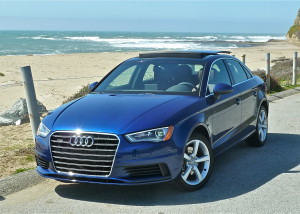Audi Expands A3 to Full Line
Filed under: Equinox, Autos
By John Gilbert
As the continuing rise of electronic gadgetry and driving controls engulfs the automobile world, I had the occasion to interview a bright young fellow who had left a prominent auto company to go to work for am aftermarket company that makes the electronic gadgets that are aiding and abetting our ability to drive, steer, control, stop, and park our contemporary cars.
I asked him of all the cars he has dealt with in his new job, which one is the most sophisticated from the standpoint of electronic connectivity. He first said the Tesla, which is an all-electric marvel but far from being a mainstream car. Of all the mainstream, readily available cars?
“The Audi A3,” he said, promptly. That is impressive, because I had just driven the first 2015 A3 at Audi’s introduction of the line, and while it is an unobtrusive car, I had noted during the introductory session and test drive, its high-level technology also made it a very sophisticated performer. The car automatically becomes Audi’s entry-level vehicle, starting at $29,900, and if you can resist the option bin you still get an impressive vehicle.
The A3 comes as a 4-door sedan first off, but that is only the leadoff hitter for a lineup of various models that will be part of a full-line segment of Audi’s impressive dossier. The well-loved 2.0-liter 4-cylinder turbocharged engine returns, upgraded to handle the quattro models with Audi’s patented all-wheel-drive system, and it will be joined by a new 1.8-liter turbo that turns the front-wheel-drive A3 into a truly sporty performer with exceptional fuel economy.
On a trip to Germany a few years ago, I first saw the Audi A3, as a smooth, sleek, compact 3-door hatchback. There were some 5-door hatches too, and they seemed to be all over. Anytime you go to Europe, you have to be impressed how European car-owners pack themselves comfortably and easily into efficiently smaller cars, even while U.S. consumers and manufacturers seemed to insist that bigger was better. A year later, when Audi brought the A3 into the U.S. market, I was anxiously awaiting the car, slightly smaller than the stellar A4 sedan, to see both the 4-door and 2-door versions rewrite some of the rules for U.S. entry-level hatchbacks.
I was mostly looking forward to the 3-door, the 2-door hatch, which was about the same size as the Volkswagen Golf. But it showed up in the U.S. market only as the 5-door, the 4-door hatch. My assumption was that Volkswagen, which is Audi’s parent, didn’t want any small hatchback to compete with the Golf, but I’ve never stopped hoping for the 3-door in the U.S.
Times have changed, although the U.S. remains a peculiar market. We seem bound by tradition, and tradition says we don’t buy hatchbacks, so we don’t. In the Volkswagen line, the Jetta 4-door sedan outsells the world-dominant 3-door Golf substantially. Not sure why, but it might have been parent Volkswagen’s decision to not bring in the A3’s 3-door hatch to protect the Golf. Regardless, sales of the 5-door A3 were disappointing, but then, that also is a hatchback.
Audi is setting its sights on changing all that for 2015 when the new generation of the A3 lands in the U.S. Leading off is the 4-door sedan, which we first were shown at the media introduction in San Francisco. No longer a blunt little 5-door subcompact hatchback, the new A3 sedan will be followed by a convertible, with an array of powerplants that starts with the 1.8-liter turbocharged 4, the 2.0 turbo upgrade, with a hotter 2.0 version coming in a soon-to-appear S3, and then a 2.0 turbodiesel model. A 1.4-liter 4 combined with an electric motor system in a hybrid will show up early next year, only in the 5-door hatch. Read more



 John Gilbert is a lifetime Minnesotan and career journalist, specializing in cars and sports during and since spending 30 years at the Minneapolis Tribune, now the Star Tribune. More recently, he has continued translating the high-tech world of autos and sharing his passionate insights as a freelance writer/photographer/broadcaster. A member of the prestigious North American Car and Truck of the Year jury since 1993. John can be heard Monday-Friday from 9-11am on 610 KDAL(www.kdal610.com) on the "John Gilbert Show," and writes a column in the Duluth Reader.
John Gilbert is a lifetime Minnesotan and career journalist, specializing in cars and sports during and since spending 30 years at the Minneapolis Tribune, now the Star Tribune. More recently, he has continued translating the high-tech world of autos and sharing his passionate insights as a freelance writer/photographer/broadcaster. A member of the prestigious North American Car and Truck of the Year jury since 1993. John can be heard Monday-Friday from 9-11am on 610 KDAL(www.kdal610.com) on the "John Gilbert Show," and writes a column in the Duluth Reader.